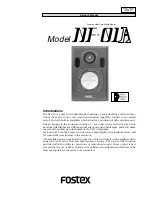
6
NF-01A (Powered Near Field Studio Monitor)
<Figure-2>
<Figure-1>
Speaker units
• HP diaphragm
“
HP
”, an abbreviation of a hyperbolic paraboloid normally
called an “
HP
” shell or “
hyper shell
”, is a 3-dimensional curved
surface structure. This HP structure is characterized
primarily by the fact that movement of a straight line
connecting 2 line segments, which do not share a single
plane, forms a hyperboloid and paraboloid.
HP diaphragm’s configuration is determined by locating
inflection points at the top and bottom to form vertical
symmetry, so as to disperse stress with pentagonal divisions
which are asymmetrical to the center of the diaphragm, as
shown on Figure-1, as the basic option, and the height of
curved surfaces is selected so that optimal frequency
dispersion as dictated by
FEM
modal analysis results can be
realized. The base diaphragm materials are
NBPK
and
banana fibers, with carbon fibers of a super high elasticity
modulus,
PBO
super-fiber and pearl mica used as
reinforcement materials, Cellgaia pulp as super damping
fibers and bio-cellulose used as the matrices material.
• UDR tangential edge
A new era has been opened by the
UDR
(Up/Down Roll)
tangential edge structure which is created by joining up-
roll and down-roll at their tangential surfaces.
It is configured, through model analyses, to function
optimally as diaphragm edges. Use of this edge is with the
woofer which plays a key part in the overall speaker system
performance.
• UFLC diaphragm
A
UFLC
diaphragm, made of polyurethane plastics which is
urethane film laminated over cloth, is used in the tweeter.
The use of a
UFLC
diaphragm allows the highest fidelity
sound reproduction which extends naturally to extremely
high frequencies, which had not been possible with
conventional soft dome technology.
• HP sound reflector
HP sound reflectors represent sound reflectors of the HP
system arranged inside the enclosure, as depicted in Figure
2. NF-01A has this type of reflectors and micron wool
arranged optimally in enclosures to diffusely reflect the
sound present in an enclosure, which creates conditions
where no standing waves may develop, and finally, for
natural attenuation.
Tangential edge
HP diaphragm
HP sound reflector
Push-pull damper
* Figures 1 and 2 above show the photographs of the Model
NF-1, which employs the same materials and
construction as the Model NF-01A. Therefore, note that
the shapes of the speaker units and sound reflector shown
above are not exactly the same as those for the NF-01A.
Setting of the system is ideal when the mid-points of
the woofer and tweeter meet the listener’s ear level to
allow full enjoyment of the NF-01A’s ability.
• Optimal listening points and setting
Center of the woofer
Center of the tweeter
Mid-point of the woofer and tweeter
Listener
15 to 30 degrees
inward
15 to 30 degrees
inward
Then, mutually orient them 15 to 30 degrees inward
to form a triangle as shown in Figure, with the open
vertex of the triangle falling at the planned listening
position. The listening position thus determined
represents the point where the design intent can be
enjoyed to the fullest extent.


























